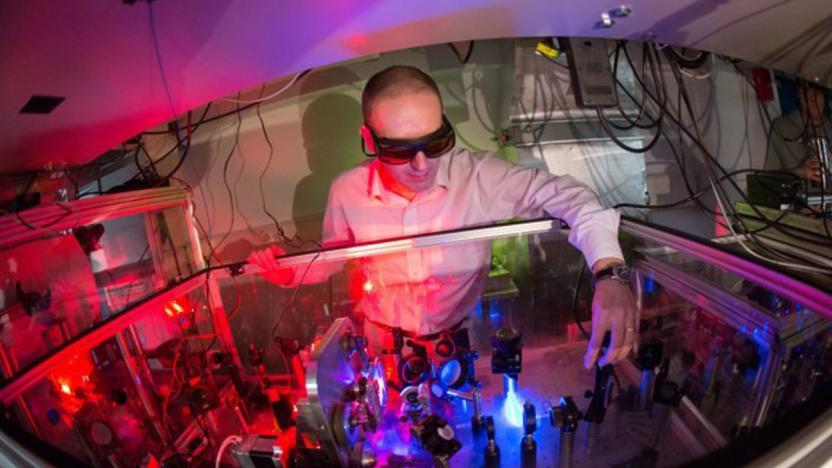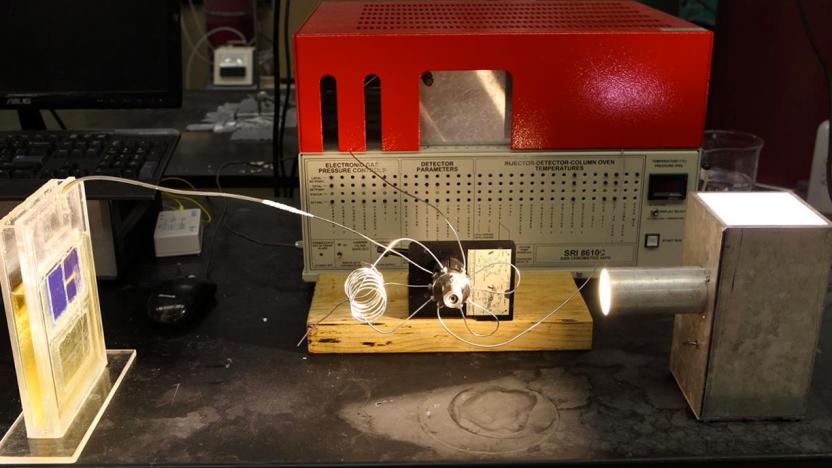photosynthesis
Latest

New solar cell generates hydrogen and electricity at the same time
In the ongoing pursuit of abundant, renewable alternatives to fossil fuels, scientists have produced hydrogen for fuel cells through artificial photosynthesis, which splits water into hydrogen and oxygen. Traditional processes have struggled to use optical, electronic and chemical properties in a way that makes this method efficient, but now researchers from Berkeley Lab have created a recipe that could completely bypass the limitations in current materials.

Super-powered bacteria can harness light for fuels and plastics
Researchers have been working on improving the photosynthetic process for some time -- trying to use light to create energy but doing so in a way that's much more efficient than chlorophyll. For plants, chlorophyll works well, but to use photosynthesis to create products like fuels or polymers, we need something that works faster and generates more output. Researchers at the University of California, Berkeley have come up with a method that does just that and they're presenting their work this week at the National Meeting and Exposition of the American Chemical Society.

Light-sensitive bacteria could save you during a heart attack
Heart attacks are frightening by themselves, but they're made worse by the potential for lasting damage. Even a brief interruption to blood flow could permanently destroy vital tissue that keeps your heart beating as usual. However, there might be a way to mitigate or even prevent that damage. Scientists have discovered that a light-sensitive bacteria, synechococcus elongatus, can keep oxygen coming in the midst of a heart attack. Much like a plant, the bacteria both draws on photosynthesis for energy and turns both CO2 and water into oxygen. If you expose it to light soon after the attack, you can maintain oxygen levels and increase the heart's blood-pumping ability after the attack is over.

Ultrafast lasers capture elusive photosynthesis reactions
Using ultra-rapid lasers, researchers have created the first "movie" of photosynthesis chemical reactions that shows exactly how fast they happen. The finding proves that a key process that strips electrons from water, starting the conversion of solar into chemical energy, happens more quickly than previously thought. "We can now see how nature has optimized the physics of converting light energy to fuel," says study author Jasper van Thor. The work could help scientists improve artificial photosynthesis to produce biofuels more efficiently.

Dutch scientists' artificial leaf can create medicine anywhere
Wouldn't it be great to have the ability to concoct medicine anywhere the sun shines, even if it's on another planet? A team of Dutch scientists from Eindhoven University of Technology have developed an artificial leaf-like device that could make that happen. The researchers, inspired by plants that can make their own food through photosynthesis, used materials that can match leaves' capability to capture and store sunlight for later use. These materials are called luminescent solar concentrators (LSCs), which have special light-sensitive molecules that can capture huge amounts of incoming light.

ICYMI: The balloon bot that can actually stand upright
try{document.getElementById("aol-cms-player-1").style.display="none";}catch(e){}Today on In Case You Missed It: A scientist at UCLA's Robotics & Mechanisms Laboratory is experimenting with a way to get around the fact that robots have a difficult time maintaining a high center of gravity, aka they always fall down; so he's built something that looks like a balloon on stick insect legs. It's still very much a prototype but perhaps the idea will remain in future walking bots. Meanwhile, scientists at SLAC came up with a way to spot photosynthesis at room temperature, using an X-ray laser. Previous tests had always relied on freezing leaves to track it. If you're getting your projects in order for the coming weekend, we recommend the DIY fire tornado. If you're looking for the Rubix Cube solving bot, that's here. As always, please share any interesting tech or science videos you find by using the #ICYMI hashtag on Twitter for @mskerryd.

X-ray laser spots photosynthesis in real-life conditions
Humanity has known about the life-giving photosynthesis process for a long time, but studying it in real-world conditions has often been impractical. You've typically had to freeze samples to get a good look, which isn't exactly natural. However, the SLAC National Accelerator Laboratory just managed a breakthrough: it used its x-ray laser to capture detailed snapshots of photosynthesis at room temperature. The trick was to place protein complex samples in a solution, put that on a conveyor belt, light it up with a green laser (to start the water-splitting reaction) and capture images using x-ray pulses. As those pulses are extremely fast -- just 40 femtoseconds long -- you can collect crystallization and spectroscopy data before the sample meets its untimely end.

Scientists turn CO2 into fuel with solar power
Researchers at the University of Illinois at Chicago believe that they've perfected the art of photosynthetic solar cells. It's a technology that mimics a plant's ability to inhale carbon dioxide and, with water, convert it into glucose and oxygen. This system is capable of drawing in carbon dioxide and processing it into a synthetic fuel that could be used to power vehicles. Theoretically, this device could create a virtuous cycle where climate-altering carbon could be removed from the atmosphere and pumped back into cars.

Six technological breakthroughs inspired by nature
By Cat DiStasio Biomimicry is an incredible field that seeks to unlock nature's deepest, darkest secrets and then use them to solve human problems. Many of the scientific breakthroughs in biomimicry have far-reaching applications ranging from new medical technologies, to methods of space exploration, advancements in renewable energy and better, cleaner and stronger building materials. The approach investigates nature's designs and seeks to replicate its processes to improve people's lives in the most efficient way possible. Inspiration can come from the most unlikely places, including long-extinct dinosaurs, sticky-footed geckos, deep sea creatures and even the structure of the tiniest green leaf. Read on to learn just a few examples of how scientists are mimicking the amazing abilities of plants and animals.

ICYMI: Cellphone motor as mic and fuel from sunlight
try{document.getElementById("aol-cms-player-1").style.display="none";}catch(e){}Today on In Case You Missed It: Researchers created a hack that lets a smartphone's vibration motor act as a microphone, picking up conversations unbeknownst to the user. Harvard University folk created fuel using artificial photosynthesis that is triple as effective as previous systems, making gas out of sunlight, CO2 and water. And finally, YouTube user BOOM LLC Robotater has a pretty entertaining potato video on the site; if you're looking for the case that lets you switch an iPhone to Android, that's here. As always, please share any great tech or science videos you find by using the #ICYMI hashtag on Twitter for @mskerryd.

Artificial 'leaf' could beat real plants at converting sunlight
Natural photosynthesis is considered a good target for solar energy conversion, but it's already considered old hat. Harvard scientists have developed a leaf-like system that should be more effective at converting solar energy than plants themselves. The technology boils down to a jar of bacteria (Ralstonia eutropha), a cobalt water-splitting system and a pair of electrodes. When you send electricity through this partly biological system, the electrodes turn the water into hydrogen gas that you can use for fuel and carbon-based materials. It's only 10 percent efficient, but that's better than the widely established 8 percent baseline for real-world performance.

Turning sunlight into clean fuel is now cheap and simple
Scientists have already produced artificial photosynthesis, but it has been an exotic process until now. You aren't about to replace the oxygen-giving plants around your home, in other words. However, researchers at Florida State University researcher have found a way to make it practical. They've developed a single-layer manganese oxide material that efficiently traps sunlight and makes it easy to break down that energy into hydrogen and oxygen. Current light-gathering techniques, like solar cells, frequently need multiple layers just to work at all -- this would be far cheaper and simpler to make.

Berkeley's artificial photosynthesis turns carbon dioxide into future fuel
Whenever a scientific discovery claims to have solved one of the world's most critical issues, it's hard not to get a little bit excited. Today, our hopes are riding high on the news that Berkeley University might have just worked out how to solve the problem of climate change. Working in collaboration with the Department of Energy and the University of California, researchers have developed a system that captures carbon dioxide and turns it into chemicals that can be used to make plastics, drugs and, even better, biofuel.

MIT's bionic plants could be used as energy factories and sensors
In many ways, plants are ideal technology hosts -- they're outdoor-friendly, self-healing and pollution-free. It only makes sense, then, that MIT scientists want to harness that potential by augmenting our leafy friends with nanotechnology. The researchers have found that injecting nanoparticles and carbon nanotubes into a plant can extend its natural abilities, or add functions that would be tricky to replicate with purely synthetic devices. One lab test supercharged photosynthesis, extracting much more energy than normal; another introduced gas sensors that could detect the nitric oxide from a car's exhaust. There's a lot of necessary refinement before bionic plants are practical, but we won't be surprised if our gardens eventually double as energy sources and air quality monitors.

University of Georgia stops plant photosynthesis to generate solar power
There's a more efficient way to harvest energy from the backyard than by wiring up hapless critters. Researchers at the University of Georgia have proof: they've discovered a way to generate electricity from plants through hijacking the photosynthesis process. By altering the proteins inside a plant cell's thylakoids, which store solar energy, scientists can intercept electrons through a carbon nanotube backing that draws them away before they're used to make sugar. While the resulting power isn't phenomenal, it's still two orders of magnitude better than previous methods, according to the university. The protein modification method may have a rosier future, as well: the team believes that it could eventually compete with solar cells, producing green energy in a very literal sense.

Panasonic Photosynthesis System converts carbon dioxide to organic material with plant-like efficiency
Greenery may fulfill a superficial need to improve the landscape aesthetic, but plants play a much more critical role in regular life function, converting carbon dioxide to oxygen through a process called photosynthesis. Panasonic is among the companies attempting to replicate this natural procedure through artificial means, and it looks like the Japanese electronics maker is well on its way towards a viable solution. Presenting at the International Conference on the Conversion and Storage of Solar Energy this week, Panasonic announced the development of an Artificial Photosynthesis System, which uses a nitride semiconductor to convert water and carbon dioxide -- a byproduct of factories and power plants -- into an organic material called formic acid, which is used in the manufacturing of dyes and fragrances. Covering the planet in formic acid wouldn't necessarily represent progress, but assuming demand isn't exceeded, it certainly beats CO2. Best yet, Panasonic claims that the system converts the substances at plant-like efficiency rates, or 0.2 percent. Hit up the PR after the break for a more granular look at the company's creation.

What if trees could be used as batteries?
Yes, our bark-skinned friends are nice and beautiful and we shouldn't mess with them too much. But here's the thing: we already chop them down for paper, so why not use their spare woody meat for batteries too? Like previous attempts at organic energy storage, it all hinges on mimicking photosynthesis. Up to the a third of the biomass of a tree is a pulpy substance called lignin, which is a by-product from paper production and which contains electro-chemically active molecules called quinones. With a bit of processing, Professor Olle Inganäs at Linköping University in Sweden reckons he can turn lignin into a thin film that can be used as cathode in a battery, and he believes it's efficient enough to start industrial-style development of the technology. "Nature solved the problem long ago", he says, and "[Lignin is] a source that never ends". Meanwhile, if you imagine Inganäs as having a long white beard and cloak, then, er, snap.

MIT professor touts first 'practical' artificial leaf, signs deal with Tata to show up real plants
A professor at MIT claims to have Mother Nature beat at her own game. Dr. Daniel Nocera says his invention is ten times more efficient at photosynthesis than a real-life leaf, and could help to bring affordable alternative energy to developing countries. Described as an "advanced solar cell the size of a poker card," the device is made of silicon, electronics, and inexpensive catalysts made of nickel and cobalt. When placed in a gallon of water under direct sunlight, the catalysts break the H2O down into hydrogen and oxygen gases, which are then stored in a fuel cell -- the energy produced is apparently enough to power a single house for a day. Of course, this isn't the first time we've seen scientists try to one-up nature, in fact, we've seen solar-powered leaves before, but this thing actually looks poised for the mass market -- Nocera signed a deal with Tata in October. Full PR after the break.

Inhabitat's Week in Green: solar buildings, solar stadiums, and an algae-powered lamp
The Week in Green is a new item from our friends at Inhabitat, recapping the week's most interesting green developments and clean tech news for us. The past week Inhabitat saw solar-powered transportation soar into space as Japan successfully unfurled the world's first solar sail aboard its Ikaros spacecraft. We continued our transportation coverage by taking a took a look at a futuristic plant-powered photosynthetic concept car that seats riders within an enclosed jungle canopy. However if the Inhabitat editors commuted to work, it would probably be via these amazing solar-powered shrub cars! In other news, the world of architecture is heating up with the onset of summer as countries around the globe gear up to unveil high-tech sun-powered homes at the European Solar Decathlon. This week we took a look at two of our favorites - the solar shelled Armadillo Box House and Finland's hyper-insulated Luuku House, which is expected to generate more energy than it consumes. We also celebrated the launch of the 2010 World Cup by taking a look at the technologies behind five stunning green stadiums that will be hosting this year's games in South Africa. Speaking of the World Cup, this week were also excited to see the unveiling of a brand new version of the sOccket, an energy-generating soccer ball that scores a goal for green power in developing countries. We also took a look at a cheap solar-powered refrigerator for the developing world that can be assembled using local materials and could save millions of lives by storing and distributing vaccines. Renewable energy was also a hot topic this week -- the UAE is blazing a trail with plans to construct a record-toppling solar plant that eclipses the size of every photovoltaic farm to date. We also saw home-grown algae power make its domestic debut in this gorgeous green Latro Lamp, which is fueled by a pond-scum powered bio-battery. And renewable energy took to the streets this week as telecom provider Orange unveiled a set of spiffy set of thermoelectric galoshes that charge your cellphone using heat from your feet. Finally, this week we unveiled some incredible new uses for everyday materials as we announced the grand-prize winners of our 2010 Spring Greening DIY Design Competition. Speaking of innovative examples of repurposed design, we were also blown away by this open-source printer made from LEGO bricks and a felt-tip pen. And if you insist on continuing to use a standard printer, you can rest assured that there's an inspired re-use for those expired ink cartridges - Australia recently unveiled a bike path made from them!

Video: MIT develops solar storage "nirvana": energy crisis solved?
MIT is in a twisted, propeller-capped knot this morning heralding a new discovery it says will unleash a solar revolution. However, the "revolutionary leap" inspired by photosynthesis is not on the glamorous front-end of energy collection, rather, it's related to a simple, highly efficient and inexpensive way to store that energy when the sun doesn't shine. "This is the nirvana of what we've been talking about for years," says Daniel Nocera, MIT neomaxizoomdweebie who with Matthew Kanan developed the unprecedented approach to split water into hydrogen and oxygen gases using the sun's energy. The gases can then be recombined later inside a fuel cell. The key components to the process are a pair of catalysts (one consists of cobalt metal, phosphate, and an electrode; the other, platinum) which produce the O and H gases at room temperature and in neutral pH water (i.e., tap water). While similar solutions exist for industrial use (primarily), these are very expensive and require specialized environments. "This is a major discovery with enormous implications for the future prosperity of humankind," said James Barber, a leader in the study of photosynthesis at Imperial College in London. "The importance of their discovery cannot be overstated since it opens up the door for developing new technologies for energy production thus reducing our dependence for fossil fuels and addressing the global climate change problem." Nocera concedes that further engineering is required to commercialize the approach but hopes to see it implemented in household fuel cell systems within the next 10 years. Click through for the video breakdown.










